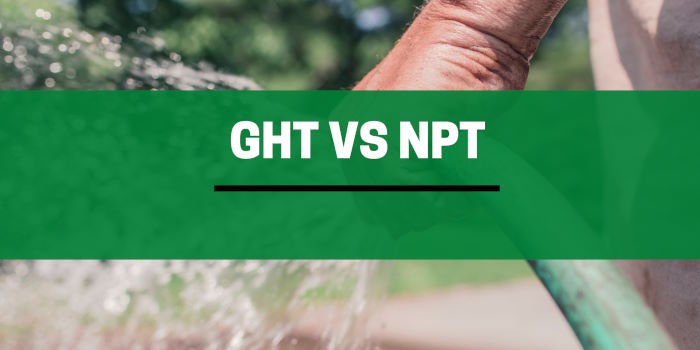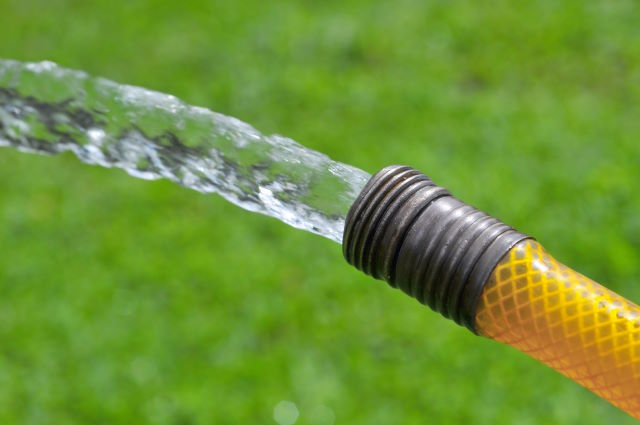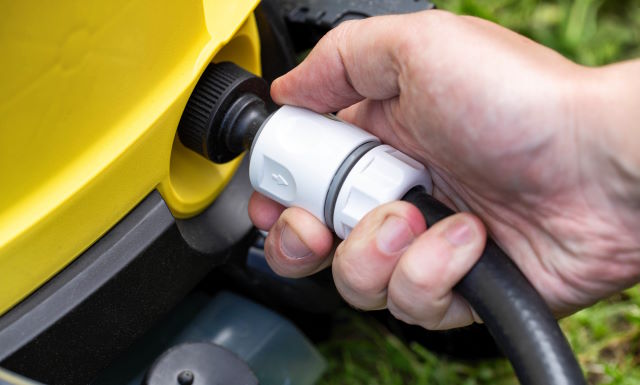Choosing the right plumbing fittings for your garden irrigation system can be a daunting task with a plethora of options in the market. GHT (Garden Hose Thread) and NPT (National Pipe Thread) being the most popular ones, their selection often leaves gardeners puzzled.
The main difference between GHT and NPT is their intended use and design. GHT is specifically designed for water hose fittings, while NPT is a more general-purpose thread used for plumbing.
GHT threads have a unique shape and size to ensure compatibility with garden hoses, while NPT threads have a different shape and size optimized for pipe connections. It’s important to use the appropriate thread type for your specific application to ensure proper functionality and avoid leaks.
Contents
Understanding GHT and NPT in Hose Fittings
These two connection types differ in their primary purpose of use. NPT connections are designed to transmit liquids and gases under pressure, while GHT is used specifically for water hose connections.
When it comes to compatibility, the two fitting types shouldn’t be used interchangeably as there can be differences in thread size, length, pitch, and angle of taper. Such slight variances can lead to improper fit or failure under pressure resulting in leaks and spills. It’s therefore critical to have a clear understanding of each connection type before making any decisions.
An international standards organization states that the key difference between NPT and GHT lies in their thread count per inch – NPT threads typically have 14 threads per inch (TPI), whereas GHT usually has 11.5 threads per inch.
NPT is an established standard in the United States as specified in the ANSI-ASME B1.20.1 regulation. To connect pipes and fittings, it mandates the use of a tapered joint with a center axis that necessitates an inclination of 1° 47′ 24” (1.7899°).
Due to the tapered nature of NPT, the threads per inch (TPI) differ as the size becomes larger. For instance, a connection measuring 3/4″ would possess an outer diameter (OD) of 1.050″ and a thread pitch of 14 TPI. While lacking official authorization, it is permissible to designate male pipe threads as MPT and female pipe threads as FPT.
To connect hoses and fittings, commonly referred to as National hose or NH, the American standard adheres to the regulations outlined in ANSI-ASME B1.20.7.
Thread Size in GHT & NPT
Threads are a key component of most fittings, with male threads found on the outside of the pipe or connections and female threads found on the inside. In general, NPT employs tapered threads with increasing diameter towards the end. GHT uses parallel threads.
However, it’s important to note that thread sizes differ between these two connection types. NPT threads have a larger diameter. GHT has an outer diameter of 1 inch (25mm) on male connections and 1 1/16 inch (27 mm) on female ones, whereas a 3/4-inch NPT male connection has an outside diameter measuring 1.050 inches while a female connection measures 0.839 inches.
| Garden Hose Thread (GHT) | National Pipe Thread (NPT) | |
|---|---|---|
| Male Diameter | 1″ | 0.839″ |
| Female Diameter | 1.062″ | 1.050″ |
Let’s suppose you are using a garden hose nozzle equipped with a threaded adapter for attaching other attachments but need to connect it to your home’s plumbing system that uses NPT connections. You need to ensure that the adapter you’re using will be able to accommodate the transition between sizes.
Comparative Pressure Ratings and Flow
When it comes to plumbing fittings, a crucial factor to consider is pressure ratings and flow. These two types differ significantly when it comes to pressure ratings.
| Garden Hose Thread (GHT) | National Pipe Thread (NPT) | |
|---|---|---|
| Max Pressure Rating | 125 PSI | 2000 PSI |
GHT or Garden Hose Thread fittings are commonly used on garden hoses, sprinklers, and taps. They have a maximum working pressure of roughly 100-125 PSI (pounds per square inch).
NPT connections, on the other hand, are used in applications that require higher pressures as they possess the capability to provide leak-free connections at very high pressures. This connection type can withstand high-pressure applications of up to 2000 PSI without leakage, making them suitable for industrial applications.
Variety of Fittings & Their Connections
There are numerous types of fittings available across various materials such as brass, plastic, copper, and stainless steel. Some primary types include combination nipples and hose menders that help in transitioning from hose to pipes or valves while also connecting or repairing lengths. Another example is slip/socket connections predominantly found in PVC fittings that consist of a female “slip” connection and a male “spigot” connector.
Push-fit connections are designed mainly for connecting thin-walled CTS CPVC or PEX tubing by merely pushing it over the tube support into the connection using no tools. Twist-and-lock connections combine push-fit and compression technology, allowing them to fasten into place by twisting the locking nut clockwise.
Plastic Quick Connect fittings function similarly to push-fit connectors with tubing being pushed into the socket of the connection.
Barbed or Insert fittings feature barbs inserted into tubing that securely keep them in place. These types generally use metal clamps or crimp rings to create a water-tight seal.
Lastly, Flare and Compression fittings typically consist of three separate pieces that firmly secure the connection as the nut is tightened. They function best for application with metal tubing.
Gender-based Fittings & Sealing Methods
Plumbing fittings are essential components for connecting pipes and other equipment to ensure the smooth flow of water. They come in various shapes and sizes, but the two main connection types covered in this article are Garden Hose Thread and National Pipe Thread.
One of the primary distinguishing factors between the two types is gender. Threads are a key component of most connector types, with male threads found on the outside of the connection and female threads found on the inside. Garden Hose Thread is a specific type of thread used for water hoses and is different from National Pipe Thread. Garden Hose Thread comes in male (MGHT) and female (FGHT) versions.
When it comes to sealing methods, there are several different options based on the type of fitting. Compression fitting seals rely on compressing an O-ring or gasket between two pieces of pipe to create a watertight seal. Soldered joints create a permanent, robust bond between pipes, ideal for pressure-carrying applications. On the other hand, Push-fit connections are used to connect CTS CPVC or PEX tubing by simply pushing the tube over the tube support into the connection.
Practical Applications & Suitability
Sprinkler heads use NPT, while garden hoses use GHT. An adapter is needed to connect standard garden hose threads to the threads on a sprinkler head. Additionally, Funny pipe can also be used as an alternative solution for extending in-ground sprinkler heads.
While these 2 types may seem compatible at first glance, it’s essential to keep in mind that garden hose threads aren’t compatible with anything other than hose thread. It would be best only to use adapters intended explicitly for GHT instead of repurposing other connector types. The trend is that people are using Funny pipes as an alternative solution for extending in-ground sprinkler heads.
| Type Of Fitting | Practical Application |
|---|---|
| Garden Hose Thread (GHT) | Garden hoses, outdoor water usage |
| National Pipe Thread (NPT) | Sprinkler heads, in-ground irrigation systems |
| Push Fit | Connecting CTS CPVC or PEX tubing |
PVC piping typically uses slip/socket joints, effectively acting as a female/male counterpart, respectively. Alternatively, when dealing with CTS CPVC or PEX tubing, push-fit connectors might be better suited as they don’t require complicated installation methods.
When selecting pipes and fittings, it is also essential to consider the material composition and choose the appropriate connectors accordingly. For example, slip/socket joints are commonly used for PVC piping, while push-fit connectors might be better suited for CTS CPVC or PEX tubing.
Usage of GHT Fittings
Garden Hose Thread (GHT) fittings are commonly used in the residential sector for outdoor attachments such as sprinklers, hoses, and nozzles. GHT threads are typically found on garden hoses and components designed to be connected to them.
An important thing to keep in mind about these fittings is that they are not interchangeable with National Pipe Thread (NPT) fittings. Attempting to connect these two types of threads can lead to leaks or damage to both the fitting and the pipe.
A common scenario involves a homeowner wanting to connect a garden hose to a spigot fitted with NPT threads. In this instance, it’s crucial to use an adapter that connects both the thread types.
Importance of Choosing Correct Fittings
With a wide variety of plumbing connectors available on the market, choosing the correct one for your project can be daunting. However, selecting them based on compatibility, function, and quality is essential when it comes to ensuring smooth water flow and preventing leaks.
An essential aspect when selecting fittings is compatibility with existing piping systems. As a rule of thumb, always use fittings with the same connection type as your pipes. For instance, if your pipes have NPT threads, ensure that you source the same threaded fittings.
Metal fittings tend to be more durable but can require additional sealing agents like Teflon tape or pipe dope to prevent leaks. On the other hand, plastic ones are resistant to corrosion and require minimal maintenance but may not stand up well in extreme temperatures.
Take into account factors like water pressure and temperature requirements. For instance, barbed/insert fittings excel at securely holding the tubing in place even under high water pressure, while twist-and-lock connections are suitable for applications that require a secure, leak-free connection.
Finally, always prioritize quality over price when selecting your connectors. While cheaper options may seem appealing, they may be of lower quality and wear much faster than premium brands.



